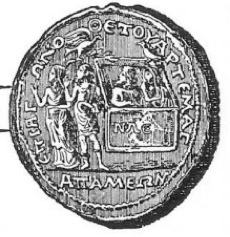



The best-known legend related to Kelainai is that of the contest between Apollo and Marsyas. It was among the most important local legends not only for Phrygia, but for the whole of Anatolia, at any rate its western part. Marsyas was accordingly depicted upon the city’s coins. The majority of sources, notably the most ancient (Hdt, 7, 26 ; Xen. An. 1, 2, cf. Anth. Gr. 6, 696; 9, 340 ; Liv. 38, 13; Strab. 12, 8,15; Ovid. Met. 6, 380-400; Lucan. 3, 206; Plut. De prov. Alexandrin. Fr. 2; Aelian. Var. hist. 13, 21; Arist. Quintil., De musica 2.18; Ps-Plut. De fluviis 10.1; Hygin. Fab. 165.4) place the contest in the city of Kelainai itself. The place of execution of the satyr is located in this tradition near the source of the river Marsyas, whose origin is attributed to the blood of the flayed Marsyas, or to the tears of the satyrs and the nymphs that were shed at his horrible fate. There is, however, an independent version, related by Pliny and borrowed from him by Solinus (40, 7-8) according to which the contest took place in the valley of Aulokrene, located ten miles from the city. The image of Marsyas in the legendary tradition is twofold. He is, on the one hand, a satyr who dwelt in the mountains near Kelainai, inventor of the flute (or the first flautist) and author of a song for the Mother of the Gods performed at festivals in her honor (Athen. 4, 82 ; Paus. 10, 30,9 etc.). On the other, he is the tutelary deity of his namesake river. On the coins of the city, the two aspects of this image are both expressed. The legends of Marsyas are of local origin; his cult, like the cult of Meander, is attested not only on coins, but likewise by literary sources (Maxim. Tyr. Diss. 2.8).
The second group of legends associated with Kelainai is related to the other famous Phrygian, the king Midas. Many legends depict Kelainai as the capital of his kingdom (Callim. Aetia, fr. 75; Sosith. Fr. 2) and say that Marsyas was initially called “the spring of Midas”; it was opened by Dionysos at the request of the Phrygian king (Ps.-Plut. De fluv. 10). Callisthenes (FGrHist 124 F 56) recounts a legend, no doubt local, according to which Zeus Idaios opened a pit at Kelainai into which several houses vanished, along with their inhabitans. An oracle informed Midas that the pit would close if he threw into it his most valuable possession. Finally, his son Anchurus threw himself in on horseback and the pit closed. At the spot, Midas erected a golden altar dedicated to Zeus Idaios. Another king of Kelainai mentioned in the legendary tradition is the illegitimate son of Midas, Lityerses. He forced travelers to work with him in his fields and defied them to see who was the fastest of the harvesters. He always won, and decapitated the losers, until he was himself decapitated by Heracles. The song of the harvesters bore the same name (Athen. 10, 8; ep. 2,2; Theoc. 10,41; Suda, s.v.; Apostol. Paroem. 10, 74).
The third legendary tradition related to Kelainai – Apamea is rather specific; it deals with the localisation in this city of Mount Ararat, where Noah’s Ark first made landfall after the Flood. This localisation is first attested in the Sibylline Oracles (1.261) and subsequently by Julius Africanus and certain Byzantine authors (Io. Mal. 1,4 ; Syncell. 22 ; Cedren. 1,20 etc.). Many coins of Apamea of the third century bear representations of Noah and his ark; the identification of the figure is assured by his name, whose Greek form is identical to that of the Septuagint (Νωε). The coins demonstrate that we are dealing with a local tradition which had no literary origin; its origin was no doubt related to the presence of a large Jewish community at Apamea.
KELAINAI - APAMEIA KIBOTOS





Image of Marsyas on a coin of Apamea

Image of Noah’s Ark on a coin of Apamea
The legends
Our research has been authorised by the Turkish Ministry of Culture and placed under the charge of the director of the Archaeological Museum of Afyonkarahisar.
M. ÜYÜMEZ
SCIENTIFIc LEADERS
A. IVANTCHIK - A. von KIENLIN - L. SUMMERER
updated: january 24, 2011


